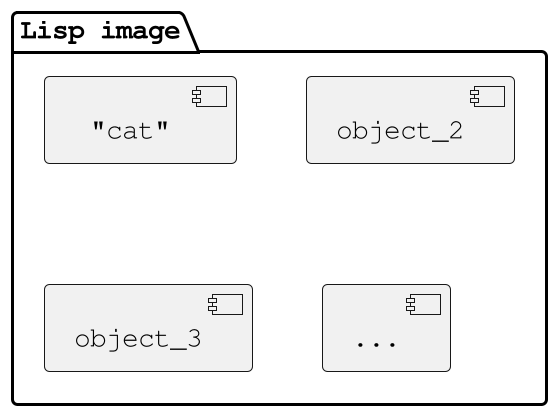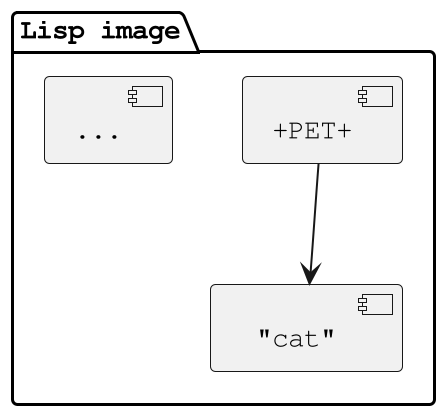Common Lisp Symbols Package Systems
Common lisp: Symbols, Packages, Systems
The Common Lisp REPL can be thought of as the program running the one-liner
(loop (print (eval (read))))
The read function implements the functionality of the Lisp
reader, who is responsible
for taking in a stream of characters and producing objects.
An object, (in case you don’t know what that is,) can be thought of as a structured region of memory.
An imaginary String object may look as follows

A reader, more generally than just in lisp, may read a line from a stream such as
String { 3, "cat" }
and create from it the object depicted in the figure.
Now let’s get to Common Lisp specifics.
The Lisp image
The Lisp image is a process that runs lisp on your computer. Just like virtual machine images, or docker images, it can be saved and restarted (hence the name). Back in the day, Lisp brought these features to the forefront thanks to its clean (and clever) design that stayed out of the way of feature building.
Although I have not used these particular features of lisp images, it
is useful to think of the lisp image as an ever-running process that
can introspect and update itself. All Common Lisp source code is fed
serially into the REPL, and the image updates itself with new
definitions, and so on. When we type "cat" at the REPL, an object
similar to the above is created in the lisp image:

Everything, or almost everything, is an object in Common Lisp.
After the object has been used in whatever functions are called that
involve it, it will linger for a bit, and then be collected by the
Garbage
Collector,
which means that it gets automatically deallocated. How does the
Garbage Collector know that the object is not needed anymore? It uses
a technique known as reference
counting. If no
other object references it, then it is not accessible. Think about our
"cat" object. How can we access it again? We could type "cat" once
more of course, but it may be a new object! (in fact this situation is
permitted in Common Lisp, as the hyperspec on the eq function
shows.) It would be rudimentary to type
(defconstant +pet+ "cat")
and thus access the same object as many times as we’d like by typing
+cat+ to the REPL. (the + surrounds are a Common Lisp naming
convention for constants.) Remember how everything was an object? Now
the situation in the lisp reader looks like this:

Since (almost) everything in Common Lisp is an object, the name (or variable) of the string is an object too. But… what kind of object is a variable name? It turns out, it is a “symbol”.
Symbols
The word symbol is interesting, but whatever you’re familiar with from the English language or other programming languages may confuse you when it comes to Common Lisp symbols.
Those so-called symbols are simply references to objects in the Lisp image. Fundamentally, they consist of two parts, a name and a value.

(We say “fundamentally” because Common Lisp symbols have more parts; and by the way, instead of “parts” they are called “slots”.)
Let us point out how the problem of accessing the cat string has been
solved. When we type +pet+ to the REPL, the reader will read +pet+
as a stream of characters, and will recognize it for a symbol. Then
something delicate happens: if the symbol name "+PET+" already has
been assigned to a symbol, that symbol will be returned by the Lisp
reader. If no such symbol exists, a brand new symbol will be created
in the Lisp image, with its value slot empty, and will be returned by
the reader. In the Lisp evaluator, symbols evaluate to their values,
which in the case of +pet+ is the cat string.
Now our string won’t be garbage collected: it is referenced by another object, a symbol. But who keeps the symbol itself from getting garbage collected? The answer is “packages”.
Packages
Packages in programming are understood as reusable abstractions, and indeed that’s what they’re used for in Common Lisp too. Nevertheless, packages in Common Lisp are very lightweight: a package keeps track of a set of symbols.
Packages are objects themselves, but they are not tracked by other
objects, but rather by the implementation. The list-all-packages
function lists the created packages. (thus, whatever keeps track of
the packages is an object itself; it is part of the implementation,
not the Common Lisp object
system.)
Pakcages are created with make-package or the
higher-level
defpackage.
Tracked symbols may be internal, inherited, or external. The external symbols of the package form its public interface. The inherited symbols are imported from other packages, as dependencies. The internal symbols are pseudo-private; they can be accessed but probably shouldn’t.
To access the value of a symbol in a package, use
(find-symbol symbol-name package-designator)
The reader has some conventions to make it less verbose to access
symbols. Remember the aforementioned delicate process? It looks up
symbols in *package*, the current package, which by default in a
fresh Lisp image is common-lisp-user. However, if the symbol is of
the form <package>::<name>, the name <name> is instead looked up
in the given package <package>, instead of the current package, and
if not found, it is created. On the other hand, if it is of the form
<package>:<name> (note the one colon instead) it is merely looked up
in the package’s external symbol list, and if not found, it is not
created.
The Lisp printer plays a part too: when symbols are printed, the prefix package is either trimmed or added, depending on whether it is the same or different to the current package.
There remains to explain what 'symbol and :keyword are, which you
have undoubtedly encountered in Common Lisp source code. The quote
character makes the evaluator return the symbol object itself instead
of its value, with all previous rules about symbol lookup and creation
from the reader applying. The colon causes the symbol to be created in
the special package KEYWORD. Symbols in this package are
self-referential!

Thus their evaluation by the evaluator returns back their own self. This trick allows us to pass keywords as arguments to functions.
So far we have described how to create a single package or a single symbol. A typical use of packages is as follows
(defpackage #:my-package
(:use :cl)
(:export #:my-function))
(in-package #:my-package)
(defun my-function ()
"Compute the answer to everything."
42)
Anyone who would like to use the above could load the file and start
using my-package:my-function, but nowadays it is common to use
ASDF for the purpose of loading
packages.
There is one additional interesting detail here, which is :use. This
is the same as calling the function use-package and it is a
relationship of packages. It makes all the symbols of the package
accessible by inheriting them. It is not possible to inherit only some
symbols, it’s all or nothing. In fact, if we then type
CL-USER> (use-package :my-package)
we obtain the following relationships

Note that cyclic relationships are allowed.
ASDF and systems
Systems load packages, but they can do more. They can manage internal and external dependencies, (with Quicklisp automatically fetching and installing external dependencies,) as well as run the test suite, build executables, other custom commands and so on.
Although the use of Quicklisp can be debated, ASDF is undebatably the way to go when distributing Common Lisp source code. Moreover, Quicklisp does not require any tinkering from the programmer; the user only has to install and configure it and then it knows what to do. Thus Quicklisp comes at zero-cost for the programmer.
ASDF has .asd files in its configured paths that tell it how to load
systems specified in asdf:load-system. Each .asd file has a
primary system and subsidiary systems, and their dependencies form
directed acyclic
graphs.
Gotchas
- It’s worthwhile to explain
#:my-function, which we used when defining a package. When the reader encounters this syntax, it launches a reader macro which transforms it to(make-symbol "MY-FUNCTION"). It would be erroneous to use'my-functionin the export section ofdefpackage, since the reader would create a new symbolmy-functionin the current package (this might be harmless, but it’s common practice in Common Lisp to use#:symbolsfor package definitions.) By the same logic we use#:my-package. Strings of course may be used too for package and symbol name designators, but they are less convenient to type out. (Because they need to be uppercase, that’s another quirk of the Lisp reader.) - Packages can’t track two symbols with the same name. That is a name clash. Name clashes can happen when importing symbols, and they can be resolved by shadowing symbols, which trump over others in name clashes.
- Does Common Lisp have a qualified import mechanism? It does not. It
is possible to have symbol clashes between dependencies when
dependending on too many ASDF systems. This can only happen however,
if the packages are used with
:use,:import-fromfromdefpackage. The user of these dependencies is supposed to write shadow rules to resolve the conflicts. This solutions scales to a certain extent, but:usecan be dangerous as accidental clobbering of symbols may occur, and:import-fromat least names the symbols so the programmer can be careful not to overwrite them. The alternative approach is to only write qualified names, e.g. usealexandria:emptypinstead ofemptyp, but this is cumbersome. There is however a solution to that! Newer releases of ASDF support:local-nicknames, which is a way to renamealexandria:to a given string, e.g.a:, in a way that is only visible when the current package is:my-package. If your ASDF version is 3.3.5 or later, you should be good to go. (check with(asdf:asdf-version).)